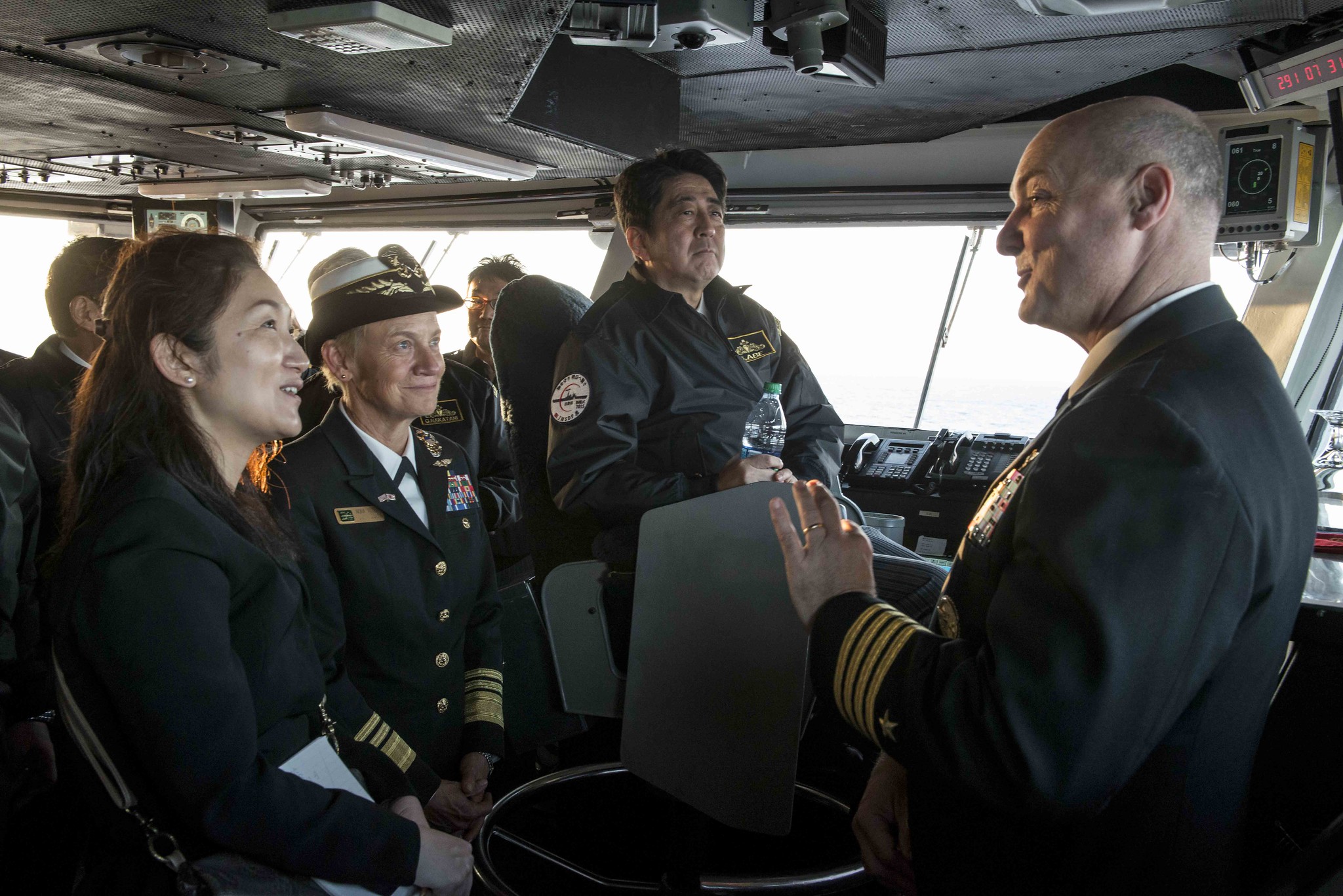
WATERS SOUTH OF JAPAN (Oct. 18, 2015) Japanese Prime Minister Shinzo Abe, center, visits aircraft carrier USS Ronald Reagan (CVN 76). The ship and its embarked air wing, Carrier Air Wing (CVW) 5, provide a combat-ready force that protects and defends the collective maritime interests of the U.S. and its allies and partners in the Indo-Pacific region At right is Capt. Christopher Bolt, the Reagan’s commanding officer. (U.S. Navy photo by Mass Communication Specialist 3rd Class Ryan McFarlane/Released)
Shinzo Abe, Japan’s longest serving prime minister, died after being shot during a campaign speech in Nara on July 8. His death shocked a nation that has prioritized peace since the end of World War II. Abe was one of Japan’s most prominent supporters of its national defense and worked with U.S. presidents of both political parties to promote a free and open Indo-Pacific. The Naval War College Foundation asked Capt. Yuki Bito, a Japan Maritime Self-Defense (JMSDF) officer, to share her reflections and perspective here. She is currently serving as a liaison officer and military professor in the international Programs Department at the U.S. Naval War College.
After Abe
By Capt. Yuki Bito, Ph.D., JMSDF Liaison Officer, U.S. Naval War College
The summer white and service dress blue uniform I wear in the Japan Maritime Self-Defense Force has four stripes, like those worn by captains in the militaries of other countries.
Some Japanese may not like to see me wear it. In Japan, the word “military” can make some people nervous. They cite a provision in our Constitution established in 1947, known as Article 9, which permanently renounces the use of war and force as a means of settling international disputes. Article 9 also does not recognize the possession of land, sea, air forces, and other war potential.
Under their strict reading of Article 9, having a military presence means Japan might provoke war. I have had several experiences in which my friends, without hesitation in front of my children, claimed JSDF is unconstitutional and may resort to violence to solve problems. I responded by using the government’s view that the SDF is a self-defense force that can be maintained.
I asked them to imagine what they would do if a burglar with a deadly weapon broke into their house, or if their precious treasure or child was about to be taken away. One woman said she would resist nonviolently, like Gandhi. My friends with strongly pacifist views still maintain that SDF is unconstitutional.
It’s an argument I cannot win. Because for more than 75 years, Japan’s Constitution has defined the SDF as responsible for the defense of the nation and the protection of the lives and property of the people.
In Japan, the word “military” can make some people nervous.
Article 9 presents Japan with many challenges. Our former prime minister Shinzo Abe wanted to address them by revising the Japanese Constitution. Unfortunately, Japan — and the United States — lost this strategically-minded leader to an act of violence on July 8, 2022. One of Abe’s goals as prime minister was to make Japan a “normal nation.” The vision of a “normal nation” was originally proposed by the politician Ichiro Ozawa. Specifically, Abe wanted to end the practice of giving up the wrongs of past wars to the younger generation and become a country that could use military force if necessary for its survival.
Abe established the National Security Council (NSC) in December 2013 to better coordinate national security and military policies of Japan. Until then, many scholars and journalists had long believed that Japan lacked the capacity for strategic thinking. Successive U.S. administrations have viewed Japan’s lack of systematic decision-making as a major disadvantage to the U.S.-Japan alliance.

Japan’s Maritime Self Defense-Force (JMSDF) JS Bungo (MST-464), left, and JS Miyajima, MSC-690, right, are decorated for the armed services’ 70th anniversary celebration in the city of Sasebo on Japan’s Kyushu Island. JAPANESE MSDF PHOTO
Actually, Abe, in his second administration, implemented the “establishment of a security arrangement” by founding the NSC, formulating a national security strategy, and allowing the limited exercise of the right to collective self-defense. But still, Opposition parties criticized Abe for referring to the Self-Defense Forces as “military forces” during a parliamentary interpellation in 2015.
Abe mentioned “Confluence on the Two Seas” during his visit to India in 2007 and subsequently gave clear strategic implications to QUAD — the four-nation alliance comprised of Japan, India, Australia and the United States — based on Asia’s Democratic Security Diamond concept in 2012. These actions set the stage to help him move quickly during the COVID pandemic to provide vaccines to Taiwan after a phone call from Taiwan’s President Tsai Ing-wen. Tsai never had the chance to extend her gratitude to Abe in person. She was waiting for him to visit Taiwan at the time of his death.
Abe’s death comes at a time of increasing tension in the Asia Pacific. Prime Minister Fumio Kishida, as well as former Prime Minister Yoshihide Suga, have both said they want to continue Abe’s push to strengthen Japan’s armed forces.
The U.S. military must keep working with still-not-yet-normalized Japanese forces to advance a stronger, strategic and more secure Japan as Abe envisioned. By limiting the scope of Japanese forces, Japan risks being in situations where it has no chance of winning.
This essay reflects the views of Capt. Bito and does not necessarily represent the JSDF or the Japanese government.
